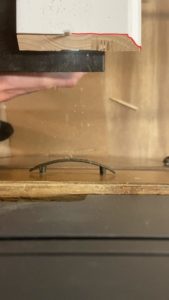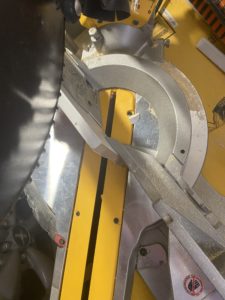I am here to help you find the best tools possible because I know the pain, writing these reviews does take time, however. ”We are a participant in the Amazon Services LLC Associates Program, an affiliate advertising program designed to provide a means for us to earn fees by linking to Amazon.com and affiliated sites.”
How to Cope With a Jigsaw
How do you cope trim?
Coping is a technique used by trim carpenters to match the end of a piece of trim with the profile of another. In a traditional miter joint the two ends on an inside corner are cut to a 45-degree angle. When using the coping method the first board is cut square and run all the way to the wall. The other board is then cut to match the profile of the first.
It may seem daunting at first, but the process of coping with a jigsaw or a coping saw is relatively easy with some practice and it has its benefits over mitering.
Benefits of Coping Trim Over Miters
-Faster
-More Precise
-Greater Room for Error/Works for More Angles appx (86-94 degrees)
How to Cope With a Jigsaw (video)
Note: I do not have the coping foot on this saw yet as I just recently switched over to the Makita XVJ01Z. The coping foot seen below is truly helpful for the more precise cuts in the detail, as it allows you to change the angle of your cut with ease.
How to Cope With a Jigsaw (steps)
1.How to Cope With a Jigsaw-Set-up
Using your saw of choice, cut the end of the board you would like to cope at a 45-degree angle with the raw edge on the finish side (see image above). Make sure to cut your trim long and then mark the board after your cope is done in case something goes wrong when coping and you need to adjust.
2.How to Cope With a Jigsaw-Cutting the End to Match the Profile/Coping

The way I like to think about this step is to get rid of any of the raw wood. You want to hold your jigsaw upside down at a slight angle inward from the edge of the trim (see image above) The angle ensures that the edge of the cope will sit nicely on the finished face of the other board.
Starting at the bottom follow the line where the painted wood meets the raw or 45-degree angled section. I marked this imaginary line in red to give you an idea of what I am talking about. Notice how the outline in red looks exactly like the profile of the base?
Once the straight portion of the cope is cut back the saw out and cut off the loose portion.
Now, the fun part, the detailed portion of the trim. Carefully follow the line where the raw wood meets the painted. It is okay to back the saw out and try from another angle. My video above might give a better idea of the process.
3.How to Cope With a Jigsaw-Finishing Steps
Check fitment and sand any missed/high spots. Now you are ready to install the base like any other trim board.

How to Cope With a Jigsaw-Fixing Mistakes
If you mess up a cope do not panic it takes a little practice. Since you haven’t cut the board to length yet you can simply take a little off the coped end at a 45-degree angle, starting the process over.
Coping Saw vs Jigsaw
Traditionally trim carpenters have used coping saws (pictured above) to make their cuts. Using a coping saw works well if you have infinite time and patience. I have grown to prefer coping with a jigsaw because of the speed and precision.
Benefits of coping with a jigsaw over a coping saw:
-Faster
-More Precise
Barrel Grip Jigsaw vs D-Grip Jigsaw
I recently picked up the Makita XVJ01 Barrel Grip Jigsaw and so far I am loving it. Having the barrel grip over the standard D-grip allows for a more natural, ergonomic feeling when coping with a jigsaw.
What is the best jigsaw for coping?
The best jigsaw for coping in my opinion is the Makita XVJ01 Barrel Grip Jigsaw. Any jigsaw will work with the right blade, but the barrel grips are definitely easier to control. The Makita XVJ01 barrel grip jigsaw has 6 speeds from 0-3500 strokes per minute. The Makita XVJ01 Barrel Grip Jigsaw automatically blows the sawdust away and has a built-in led light so you can stay on your line. Check out the full review here.
What is the best jigsaw blade for coping?
The best jigsaw blade for coping is going to be something around 6 teeth per inch. At first glance, the blade might seem like it is too coarse to make such a precision cut. I too was skeptical, but after using the 6 tooth blade for coping with a jigsaw, I will not go back. Since you are cutting from the backside of the wood, when the teeth come down they are pulling the rough edge inward, creating a smooth profile on the front of the wood.
What is the best jigsaw accessory for coping/what is the best Makita Jigsaw coping foot?
The best jigsaw accessory for coping is hands down, the Collins Coping Foot. the Collins Coping Foot replaces the standard angled end panel for your jigsaw. Essentially it allows you to change the angle of your saw to whatever angle you need to match the profile of trim instantaneously. The Collins coping foot is also the best Makita Jigsaw coping foot.
How to Cope With jigsaw-Recap
The first step is to cut the end of the board at a 45-degree angle.
Second, set your jigsaw up with a 6 tooth per inch wood blade.
Third, secure the piece of trim you are working on with clamps.
Now, put the jigsaw in a fast setting and flip it upside down. Follow the line, cutting where the end of the trim profile transitions to a 45-degree angle. I like to think of it as the line where the raw wood meets the paint.
Be careful at the top end of the trim as the profile gets thinner, it is easier to break.
Once finished with the cutting, check the fitment against another piece of trim, then sand any high spots to improve fitment.
Why Cope With a Jigsaw?
Coping with a jigsaw is faster and easier than coping with a coping saw.
Thank You For Reading
Check out our other articles and a review of the best cordless brad nailer




